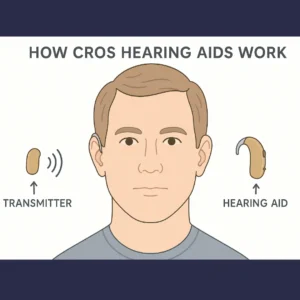If you have hearing loss in one ear and normal hearing in the other, you’re not alone. This condition, called unilateral hearing loss or single-sided deafness (SSD), affects thousands of Americans each year. A CROS hearing aid offers a smart solution. It reroutes sound from your weaker side to your better-hearing ear, giving you improved access to the world around you—especially in noisy places.
Learn more about hearing loss through common faqs on hearing loss.
What Does “CROS” Mean?
CROS stands for Contralateral Routing of Signal. This term refers to the way sound is transferred from one side of the head to the other. If you have no usable hearing in one ear but normal hearing in the other, a CROS hearing aid helps you hear sounds that you would otherwise miss on your impaired side.
Rather than trying to restore hearing in your poor ear (which often isn’t possible), the device picks up sound on that side and sends it wirelessly to your good ear. This simple rerouting restores your ability to hear sound from both directions.

How Does a CROS Hearing Aid Work?
A CROS system uses two separate devices:
- A transmitter worn on your non-hearing (poorer) ear.
- A receiver, or hearing aid, worn on your better-hearing ear.
Here’s how it works:
- The transmitter picks up sounds from your deaf or near-deaf ear using a built-in microphone.
- It wirelessly transmits those sounds to the receiver.
- The receiver plays those sounds into your good ear, letting you hear from both sides of your environment.
CROS systems help address a major challenge of single-sided hearing loss known as the head shadow effect. When sound comes from your deaf side, your head acts as a barrier—especially for high-frequency sounds like consonants. This means you may not hear someone speaking on your poor side or may have difficulty following conversations in noise.
With a CROS hearing aid, you no longer have to constantly reposition yourself to hear what’s happening. You can simply listen through your better ear while staying aware of both sides.
What Is a BiCROS Hearing Aid?
A BiCROS hearing aid is similar in design but helps people who have some hearing loss in their better ear, too.
BiCROS systems also include two parts:
- A transmitter on the side with no usable hearing.
- A receiver/amplifier on the side with better (but not perfect) hearing.
Here’s the process:
- The transmitter captures sound from the non-hearing side.
- The receiver not only plays that sound into the better ear but also amplifies all incoming sound to compensate for its own hearing loss.
This dual-action system allows people with hearing loss in both ears—where one ear is significantly worse—to still benefit from sounds on both sides. It gives users more balanced hearing while minimizing the need to constantly turn their head or miss environmental cues.

Who Should Consider a CROS or BiCROS Hearing Aid?
You may be a candidate if:
- One ear has no usable hearing or significantly poorer hearing.
- You struggle to follow conversations in noisy settings.
- You find it difficult to tell where sounds are coming from.
- You’ve been diagnosed with unilateral hearing loss or asymmetric hearing loss.
Common causes include:
- Viral infections that damage the auditory nerve.
- Traumatic injuries to the head or ear.
- Acoustic neuroma, a noncancerous tumor on the hearing nerve.
- Ménière’s disease, which causes fluid buildup in the inner ear.
- Sudden sensorineural hearing loss with no response to medical treatment.
If your better ear still hears well, your hearing care provider may recommend a CROS system. If your better ear also has some hearing loss, they may suggest a BiCROS system with appropriate amplification on both sides.
Find out more about custom hearing aids.
Why Not Just Amplify the Poor Ear?
This is a common question—but the answer involves understanding how hearing loss works.
When an ear has very poor word recognition or dead cochlear regions, simply turning up the volume won’t help. Instead of improving speech clarity, this can create distortion or rollover loss—a condition where increasing volume makes speech harder to understand.
Other challenges include:
- Recruitment, where loud sounds become uncomfortable quickly.
- Reduced dynamic range, making it hard to balance soft and loud sounds.
- Cross-hearing, where amplified sound leaks into the better ear, creating confusion.
A CROS or BiCROS system helps avoid these problems by preserving the sound quality in the better ear while still restoring awareness from the poor side.
Getting Used to a CROS Hearing Aid
CROS hearing aids feel different at first. Since sound from your poor side is suddenly heard in your good ear, your brain needs time to adjust. Some people may feel confused or overwhelmed in noisy places until they adapt.
To improve your adjustment:
- Wear your hearing aids all day, not just occasionally.
- Be patient—adaptation may take several weeks.
- Work with your provider for programming tweaks and support.
With consistent use, your brain will learn to process the new sound pattern and separate useful signals from background noise.
Key Benefits of CROS and BiCROS Hearing Aids
CROS and BiCROS systems provide significant advantages for people with single-sided or asymmetrical hearing loss.
Top benefits include:
- Improved awareness of sounds on both sides
- Reduced listening effort
- Better speech understanding in noise
- No surgery required
- Customizable styles and features
You no longer need to rely solely on lip-reading, head-turning, or strategic positioning to hear conversations. You can feel more confident in meetings, restaurants, and social settings.
Limitations to Keep in Mind
While CROS and BiCROS hearing aids are powerful tools, they do have limitations:
- They don’t restore directional hearing (you may still struggle to localize sounds).
- Background noise may still interfere, depending on your environment.
- The sound may feel less natural at first due to routing.
These devices won’t “fix” hearing loss, but they offer a much more functional hearing experience than going unaided.

Advances in Modern CROS Hearing Aids
Today’s CROS systems are sleeker, smarter, and more discreet than ever.
Modern features include:
- Wireless connectivity with smartphones and TVs
- Rechargeable batteries for convenience
- Streaming compatibility with music and phone calls
- App control for personal adjustments and support
Many models also offer directional microphones and noise reduction to help you focus on speech. Some even include remote microphones to help in group settings or classrooms.
Leading Brands Offering CROS Hearing Aids
Here’s a breakdown of top manufacturers and what they offer:
Phonak
- Models: CROS Lumity, CROS Paradise, CROS II
- Works with: Audéo Lumity, Naída Lumity, Sky Lumity
- Highlights: Rechargeable options, MyPhonak app, Roger™ microphone compatibility
Starkey
- Models: Genesis AI, Evolv AI, Livio AI
- Compatible with: RIC, BTE, and ITE styles
- Highlights: Full streaming, directional microphones, accessories for group listening
Oticon
- Models: CROS PX, miniRITE
- Compatible with: Real, Intent, Zircon, and Ruby
- Highlights: TwinLink™ for simultaneous Bluetooth and near-field streaming
Signia
- Models: Pure Charge&Go IX, Silk IX, Styletto AX
- Highlights: First rechargeable CIC CROS option, advanced motion sensors, Bluetooth LE support
ReSound
- Model: Nexia Micro RIE CROS
- Highlights: Smallest RIE CROS available, Auracast™ ready, streaming in public spaces
Are There Alternatives to CROS and BiCROS?
While CROS hearing aids are often the best solution for SSD, alternatives may include:
- Bone-anchored hearing devices (BAHDs), which send sound through bone conduction.
- Cochlear implants, for certain cases of profound unilateral loss.
- Communication counseling, including tips for managing conversations.
- Sound localization training with auditory rehabilitation.
Some people choose a non-technological approach at first, depending on lifestyle and hearing goals. Your hearing care provider can walk you through the pros and cons of each option.
Discover how your hearing aid insurance benefits can help.
Choosing the Right CROS System for You
When selecting a CROS or BiCROS hearing aid, consider:
- Hearing levels in both ears
- Style preferences (RIC, BTE, or custom)
- Desire for rechargeability
- Streaming and Bluetooth compatibility
- Support from a qualified hearing care provider
At American Hearing + Audiology, we take all these factors into account to find your best fit.
Hear Life Fully Again
Single-sided deafness used to mean missing out. Today, CROS hearing aids offer a powerful solution. Whether you need basic sound awareness or full streaming capabilities, these systems help you reconnect with life.
Wondering if a CROS hearing aid is right for you? Our hearing care providers will assess your needs, explain your options, and provide expert guidance. We work with all major brands and offer in-person and remote consultations.
Contact American Hearing + Audiology today. Better hearing on both sides starts here.



